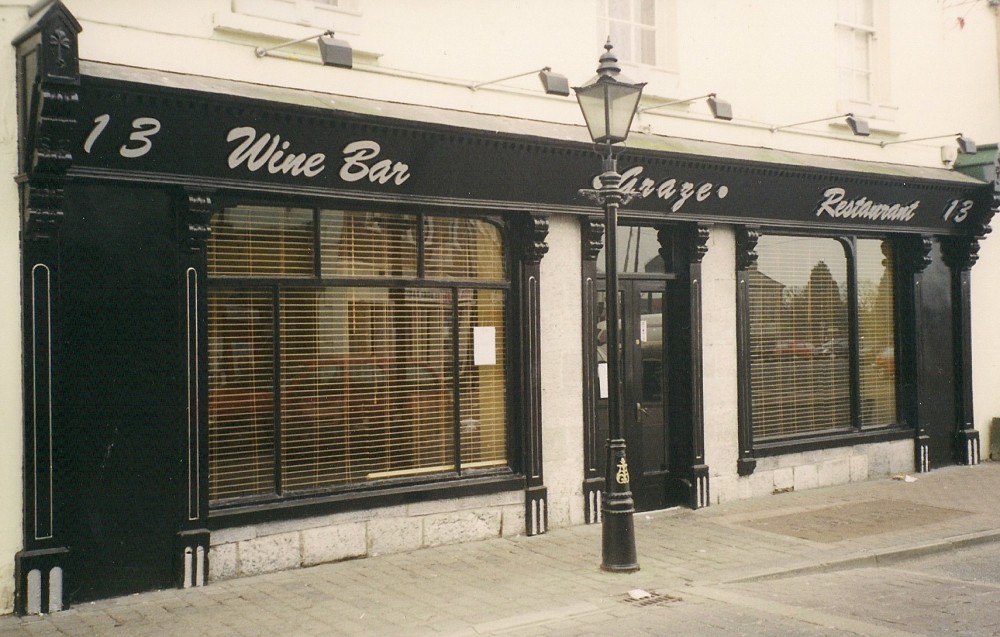In the 18th and early 19th centuries, law and order in Ireland was enforced by the Baronial Police - known as the "Old Barneys",
they were a rough and ready lot who didn't wear set uniforms and dealt mostly with minor crimes - and numerous local militias. The Bank of Ireland,
incidentally, had its own private militia which not only protected it from robbers, but enforced judgements against debtors
and also took part in evictions. In 1814, The Peace Preservation Force was established by Chief Secretary for Ireland, Robert Peel whose name inspired the term
'Bobby' still in use in today, and 'Peeler' as in the old ballad The Peeler and the Goat. Eight years later, a new force called the
Constabulary Police was formed and, for the first time, Ireland had a well-organised, national police force. In 1839 the Police Barracks and the old
County Gaol occupied the site of the Dunamaise Arts Centre in Church Street.
It wasn't until 1867 that 'Royal' was added to 'Irish Constabulary'. The title was granted by Queen Victoria in recognition of the force's work
in suppressing the Fenian Rising and thus became the first 'Royal' police force in the British Empire.
A map accompanying Griffith's Valuation of 1851 designates two buildings as barracks; one in Main Street
(O'Loughlin's Hotel today); the other on the site of the above restaurant. At the same time, the actual Valuation list gives an Owen Dunne as the occupier
of the property. I'm sure there's a logical explanation for this apparent contradiction, but, so far, it has eluded me.
The building was leased from Robert Graves1, and what is also unclear is his connection with his namesake who, in 1824, was a Soap Boiler and Chandler in the town.
A Bartholomew Graves was also a tallow chandler. The local 'Graveses' originated in County Meath. Thomas Graves, son of William Graves (died 1682) of
Rathmullan moved to Queen's County where he raised sheep and was
also a skinner and glover.
Anyway, in 1884, the Royal Irish Constabulary force for the Queen's County numbered six officers and 240 men. On Census Night 1901, the following were
present in this barracks: a Head Constable (from County Meath), his wife and five young children, plus a sergeant and eight constables. All the
policemen were originally farmers and all, excluding the Head Constable, were Catholic. Not at all surprising when you
consider that the RIC was made up of eighty-percent Catholic personnel.
Some of the holding cells at the rere of the building, incidentally, survived until the 1960's, decades after the last detainees were moved on.
After the RIC was disbanded in August 1922 (and replaced by the Civic Guards, later known as An Garda Síochána),
these premises - dating from the 1850's and thus one of the oldest in the Square - were acquired by James J. Gray and his wife Margaret, née Burke.
Like his father before him in Lower Main Street, he
was a cabinet-maker and furniture restorer. He died in 1967, aged 86. His wife
was a milliner and had a hat and glove shop here until 1932 when she established Gray's restaurant (Enjoy your Meal in
Comfort, Warmth and Friendliness) which, over the years, became an eminent landmark in the town.
Mrs Gray also ran a boarding house; one of her granddaughters recalls hearing about the German workers
who stayed here in the 1930's when they were building the silver silos - for Odlum's Mill - which once towered over Church Avenue.
Later in that decade, and prior to the aforementioned Tony O'Connor's shop, the portion behind the window on the right was occupied by
Francis Slater's Betting Office.
In the 1960's it was not unusual to see buses parked in the Square and lines of tourists - mostly Americans
of a certain age - stopping the traffic on Main Street as they trooped across to dine in Gray's.
On days the nearby Court was sitting, the restaurant also catered for a more sombre clientele; the proverbial twelve good men and true.
In 1987, Mrs Margaret Gray was given the honour of switching on the Christmas Lights but, three years later, there was widespread regret at the news that
one of the town's most venerable citizens had passed away. She was 93. The restaurant was subsequently managed by various people trading under a variety of names: Belcort,
Graze, Alanna's, the Square Meal, and currently (2014), The Pantry.
1
If you had been around the town in May 1776 you might have spotted a dark brown cow branded with the letters PK on its horn.
Mr Graves had reported the animal "stolen or strayed off the Commons of Maryborough", and offered a reward for anyone who contacted him with "intelligence
of the same cow, by letter or otherwise".



HOMEPAGE